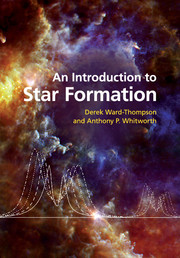Book contents
- Frontmatter
- Contents
- List of Illustrations
- Preface
- 1 Introduction
- 2 Probing star formation
- 3 The ISM – the beginnings of star formation
- 4 Molecular clouds – the sites of star formation
- 5 Fragmentation and collapse – the road to star formation
- 6 Young stars, protostars and accretion – building a typical star
- 7 The formation of high-mass stars, and their surroundings
- 8 By-products and consequences of star formation
- List of mathematical symbols
- List of figure credits
- Index
- References
7 - The formation of high-mass stars, and their surroundings
Published online by Cambridge University Press: 05 June 2012
- Frontmatter
- Contents
- List of Illustrations
- Preface
- 1 Introduction
- 2 Probing star formation
- 3 The ISM – the beginnings of star formation
- 4 Molecular clouds – the sites of star formation
- 5 Fragmentation and collapse – the road to star formation
- 6 Young stars, protostars and accretion – building a typical star
- 7 The formation of high-mass stars, and their surroundings
- 8 By-products and consequences of star formation
- List of mathematical symbols
- List of figure credits
- Index
- References
Summary
Introduction
In this chapter we look at those phenomena associated with the formation of higher-mass stars. High-mass stars are usually defined as stars of mass ~8 M⊙ or more. This definition is usually taken, since any star of this mass has typically already begun hydrogen burning before the accretion stage has finished. This provides some problems in dealing with the formation of such stars, since one cannot separate observationally the luminosity due to the accretion, from the intrinsic luminosity of the protostar.
However, the study of high-mass stars is important from the point of view of large-scale studies of galaxies, since the luminosity of a galaxy is typically dominated by the luminosity of its highest mass stars. Hence the observed evolution of a galaxy in terms of its colours and spectra is dominated by the continued formation and evolution of its constituent high-mass stars. Furthermore, high-mass stars are the dominant sources of energy input into the interstellar medium. Hence they are very important for the dynamics and energy budget of a galaxy. In particular, the HII region phase (see below) is particularly important for ionising the gas in the interstellar medium.
Observing high-mass star formation is further complicated by a number of factors. High-mass stars are rarer than low-mass stars, hence the nearest high-mass star-forming regions are on average further away than their low-mass counterparts, making the spatial resolution of observations proportionately lower.
- Type
- Chapter
- Information
- An Introduction to Star Formation , pp. 143 - 172Publisher: Cambridge University PressPrint publication year: 2011



